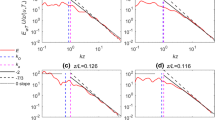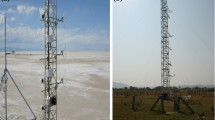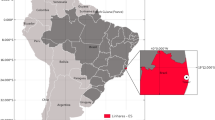Abstract
The turbulent energy spectra and cospectra of momentum and sensible heat fluxes are examined theoretically and experimentally with increasing flux Richardson number (\(\textit{Rf}\)) in the stable atmospheric surface layer. A cospectral budget model, previously used to explain the bulk relation between the turbulent Prandtl number (\(Pr_\mathrm{t}\)) and the gradient Richardson number (\(\textit{Ri}\)) as well as the relation between \(\textit{Rf}\) and \(\textit{Ri}\), is employed to interpret field measurements over a lake and a glacier. The shapes of the vertical velocity and temperature spectra, needed for closing the cospectral budget model, are first examined with increasing \(\textit{Rf}\). In addition, the wavenumber-dependent relaxation time scales for momentum and heat fluxes are inferred from the cospectral budgets and investigated. Using experimental data and proposed extensions to the cospectral budget model, the existence of a ‘\(-1\)’ power-law scaling in the temperature spectra but its absence from the vertical velocity spectra is shown to reduce the magnitude of the maximum flux Richardson number (\(\textit{Rf}_\mathrm{m}\)), which is commonly inferred from the Rf–Ri relation when \(\textit{Ri}\) becomes very large (idealized with \(\textit{Ri} \rightarrow \infty \)). Moreover, dissimilarity in relaxation time scales between momentum and heat fluxes, also affected by the existence of the ‘\(-1\)’ power-law scaling in the temperature spectra, leads to \(Pr_\mathrm{t} \ne 1\) under near-neutral conditions. It is further shown that the production rate of turbulent kinetic energy decreases more rapidly than that of turbulent potential energy as \(\textit{Rf}\rightarrow \textit{Rf}_\mathrm{m}\), which explains the observed disappearance of the inertial subrange in the vertical velocity spectra at a smaller \(\textit{Rf}\) as compared to its counterpart in the temperature spectra. These results further demonstrate novel linkages between the scale-wise turbulent kinetic energy and potential energy distributions and macroscopic relations such as stability correction functions to the mean flow and the \(Pr_\mathrm{t}\)–Ri relation.




Similar content being viewed by others
References
Ansorge C, Mellado JP (2014) Global intermittency and collapsing turbulence in the stratified planetary boundary layer. Boundary-Layer Meteorol 153(1):89–116
Bos W, Bertoglio J (2007) Inertial range scaling of scalar flux spectra in uniformly sheared turbulence. Phys Fluids 19:025104–025111
Bos W, Touil H, Shao L, Bertogli J (2004) On the behavior of the velocity-scalar cross correlation spectrum in the inertial range. Phys Fluids 16:3818–3823
Bou-Zeid E, Higgins C, Huwald H, Parlange M, Meneveau C (2010) Field study of the dynamics and modelling of subgrid scale turbulence in a stable atmospheric surface layer over a glacier. J Fluid Mech 665:480–515
Bouruet-Aubertot P, Van Haren H, Lelong MP (2010) Stratified inertial subrange inferred from in situ measurements in the bottom boundary layer of the Rockall channel. J Phys Oceanogr 40(11):2401–2417
Businger JA, Yaglom AM (1971) Introduction to Obukhov’s paper on ‘Turbulence in an atmosphere with a non-uniform temperature’. Boundary-Layer Meteorol 2:3–6
Businger JA, Wyngaard JC, Izumi Y, Bradley EF (1971) Flux–profile relationships in the atmospheric surface layer. J Atmos Sci 28(2):181–191
Calaf M, Hultmark M, Oldroyd H, Simeonov V, Parlange M (2013) Coherent structures and the \(k^{-1}\) spectral behaviour. Phys Fluids 25(12):125,107
Cava D, Katul G (2012) On the scaling laws of the velocity-scalar cospectra in the canopy sublayer above tall forests. Boundary-Layer Meteorol 145:351–367
Cava D, Giostra U, Siqueira M, Katul G (2004) Organised motion and radiative perturbations in the nocturnal canopy sublayer above an even-aged pine forest. Boundary-Layer Meteorol 112(1):129–157
Chung D, Matheou G (2012) Direct numerical simulation of stationary homogeneous stratified sheared turbulence. J Fluid Mech 696:434–467
Corrsin S (1961) The reactant concentration spectrum in turbulent mixing with a first-order reaction. J Fluid Mech 11:407–416
Cot C (2001) Equatorial mesoscale wind and temperature fluctuations in the lower atmosphere. J Geophys Res 106(D2):1523–1532
Davidson PA, Kaneda Y, Sreenivasan KR (2012) Ten chapters in turbulence. Cambridge University Press, New York, 450 pp
Derbyshire S (1999) Stable boundary-layer modeling: established approaches and beyond. Boundary-Layer Meteorol 90:423–446
Deusebio E, Brethouwer G, Schlatter P, Lindborg E (2014) A numerical study of the unstratified and stratified Ekman layer. J Fluid Mech 755:672–704
Fernando H (1991) Turbulent mixing in stratified fluids. Annu Rev Fluid Mech 23:455–493
Fernando H, Weil J (2010) Whither the stable boundary layer? A shift in the research agenda. Bull Am Meteorol Soc 91:1475–1484
Foken T (2006) 50 years of the Monin–Obukhov similarity theory. Boundary-Layer Meteorol 19:431–447
Galperin B, Sukoriansky S (2010) Geophysical flows with anisotropic turbulence and dispersive waves: flows with stable stratification. Ocean Dyn 60(5):1319–1337
Galperin B, Sukoriansky S, Anderson PS (2007) On the critical Richardson number in stably stratified turbulence. Atmos Sci Lett 8:65–69
Gioia G, Guttenberg N, Goldenfeld N, Chakraborty P (2010) Spectral theory of the turbulent mean-velocity profile. Phys Rev Lett 105:184501
Grachev A, Andreas E, Fairall C, Guest P, Persson PG (2007) On the turbulent Prandtl number in the stable atmospheric boundary layer. Boundary-Layer Meteorol 125:329–341
Grachev A, Andreas E, Fairall C, Guest P, Persson PG (2013) The critical Richardson number and limits of applicability of local similarity theory in the stable boundary layer. Boundary-Layer Meteorol 147:51–82
Högström U (1996) Review of some basic characteristics of the atmospheric surface layer. In: Boundary-Layer Meteorology 25th Anniversary Volume, 1970–1995, Springer, pp 215–246
Holtslag AAM et al (2013) Stable atmospheric boundary layers and diurnal cycles: challenges for weather and climate models. Bull Am Meteorol Soc 94:1691–1706
Howard LN (1961) Note on a paper of John W. Miles. J Fluid Mech 10(4):509–512
Huang J, Bou-Zeid E, Golaz JC (2013) Turbulence and vertical fluxes in the stable atmospheric boundary layer. Part 2: A novel mixing-length model. J Atmos Sci 70(6):1528–1542
Huwald H, Higgins C, Boldi M, Bou-Zeid E, Lehning M, Parlange M (2009) Albedo effect on radiative errors in air temperature measurements. Water Resour Res 45:W08431
Ishihara T, Yoshida K, Kaneda Y (2002) Anisotropic velocity correlation spectrum at small scales in a homogeneous turbulent shear flow. Phys Rev Lett 88:154501
Janjić ZI (2002) Nonsingular implementation of the Mellor–Yamada level 2.5 scheme in the ncep meso model. NCEP office note 437:61
Kader B, Yaglom A (1991) Spectra and correlation functions of surface layer atmospheric turbulence in unstable thermal stratification. In: Metais O, Lesieur M (eds) Turbulence and coherent structures. Kluwer Academic Publishers, Boston, pp 450–467
Kaimal J, Finnigan J (1994) Atmospheric boundary layer flows: their structure and measurement. Oxford University Press, New York, 289 pp
Kaimal JC (1973) Turbulence spectra, length scales and structure parameters in the stable surface layer. Boundary-Layer Meteorol 4:289–309
Kaimal JC, Izumi Y, Wyngaard JC, Cote R (1972) Spectral characteristics of surface-layer turbulence. Q J R Meterol Soc 98(417):563–589
Katul G, Chu C (1998) A theoretical and experimental investigation of energy-containing scales in the dynamic sublayer of boundary-layer flows. Boundary-Layer Meteorol 86:279–312
Katul G, Manes C (2014) Cospectral budget of turbulence explains the bulk properties of smooth pipe flow. Phys Rev E 90(063):008
Katul G, Chu C, Parlange M, Albertson J, Ortenburger T (1995) Low-wavenumber spectral characteristics of velocity and temperature in the atmospheric surface layer. J Geophys Res 100(D7):14,243–14,255
Katul G, Albertson J, Hsieh C, Conklin P, Sigmon J, Parlange M, Knoerr K (1996) The ‘inactive’ eddy motion and the large-scale turbulent pressure fluctuations in the dynamic sublayer. J Atmos Sci 53(17):2512–2524
Katul G, Schieldge J, Hsieh CI, Vidakovic B (1998) Skin temperature perturbations induced by surface layer turbulence above a grass surface. Water Resour Res 34(5):1265–1274
Katul G, Mahrt L, Poggi D, Sanz C (2004) One and two equation models for canopy turbulence. Boundary-Layer Meteorol 113:81–109
Katul G, Konings A, Porporato A (2011) Mean velocity profile in a sheared and thermally stratified atmospheric boundary layer. Phys Rev Lett 107:268502
Katul G, Porporato A, Nikora V (2012) Existence of \(k^{-1}\) power-law scaling in the equilibrium regions of wall-bounded turbulence explained by Heisenberg’s eddy viscosity. Phys Rev E 86(1):066311
Katul G, Li D, Chamecki M, Bou-Zeid E (2013) Mean scalar concentration profile in a sheared and thermally stratified atmospheric surface layer. Phys Rev E 87(2):023004
Katul G, Porporato A, Shah S, Bou-Zeid E (2014) Two phenomenological constants explain similarity laws in stably stratified turbulence. Phys Rev E 89(1):023007
Kays W (1994) Turbulent Prandtl number—where are we? J Heat Transf 116:284–295
Kolmogorov A (1941a) Dissipation of energy under locally isotropic turbulence. Dokl Akad Naukl SSSR 32:16–18
Kolmogorov A (1941b) The local structure of turbulence in imcompressible viscous fluid for very large Reynolds numbers. Dokl Akad Naukl SSSR 30:299–303
Launder B, Reece G, Rodi W (1975) Progress in the development of a Reynolds-stress turbulence closure. J Fluid Mech 68:537–566
Li D, Bou-Zeid E (2011) Coherent structures and the dissimilarity of turbulent transport of momentum and scalars in the unstable atmospheric surface layer. Boundary-Layer Meteorol 140(2):243–262
Li D, Bou-Zeid E, de Bruin H (2012a) Monin–Obukhov similarity functions for the structure parameters of temperature and humidity. Boundary-Layer Meteorol 145(1):45–67
Li D, Katul G, Bou-Zeid E (2012b) Mean velocity and temperature profiles in a sheared diabatic turbulent boundary layer. Phys Fluids 24(10):105105
Li D, Katul G, Zilitinkevich S (2015) Revisiting the turbulent Prandtl number in an idealized atmospheric surface layer. J Atmos Sci 72(6):2394–2410
Lumley J (1967) Similarity and the turbulent energy spectrum. Phys Fluids 10:855–858
Mahrt L (1999) Stratified atmospheric boundary layers. Boundary-Layer Meteorol 90:375–396
Mahrt L (2014) Stably stratified atmospheric boundary layers. Annu Rev Fluid Mech 46:23–45
Miles J, Howard L (1964) Note on heterogeneous shear flow. J Fluid Mech 20:331–336
Miles JW (1961) On the stability of heterogeneous shear flows. J Fluid Mech 10(04):496–508
Monin A, Obukhov A (1954) Basic laws of turbulent mixing in the ground layer of the atmosphere. Akad Nauk SSSR Geofiz Inst Trudy 151:163–187
Monin A, Yaglom A (1971) Statistical fluid mechanics, vol 1. MIT Press, Cambridge, 782 pp
Obukhov A (1946) Turbulence in thermally inhomogeneous atmosphere. Trudy Inta Teoret Geofiz Akad Nauk SSSR, pp 95–115
Perry A, Henbest S, Chong M (1986) A theoretical and experimental study of wall turbulence. J Fluid Mech 165:163–199
Perry AE, Abell CJ (1975) Scaling laws for pipe-flow turbulence. J Fluid Mech 67:257–271
Perry AE, Abell CJ (1977) Asymptotic similarity of turbulence structures in smooth- and rough-walled pipes. J Fluid Mech 79:785–799
Pond S, Smith S, Hamblin P, Burling R (1966) Spectra of velocity and temperature fluctuations in the atmospheric boundary layer over the sea. J Atmos Sci 23:376–386
Pope S (2000) Turbulent flows. Cambridge University Press, Cambridge, 802 pp
Poulos GS, Blumen W, Fritts DC, Lundquist JK, Sun J, Burns SP, Nappo C, Banta R, Newsom R, Cuxart J et al (2002) CASES-99: a comprehensive investigation of the stable nocturnal boundary layer. Bull Am Meteorol Soc 83(4):555–558
Riley JJ, Lindborg E (2008) Stratified turbulence: a possible interpretation of some geophysical turbulence measurements. J Atmos Sci 65(7):2416–2424
Salesky S, Katul G, Chamecki M (2013) Buoyancy effects on the integral length scales and mean velocity profile in atmospheric surface layer flows. Phys Fluids 25(10):105101
Sandu I, Beljaars A, Bechtold P, Mauritsen T, Balsamo G (2013) Why is it so difficult to represent stably stratified conditions in numerical weather prediction (NWP) models? J Adv Model Earth Syst 5:117–133
Skamarock WC, Klemp JB (2008) A time-split nonhydrostatic atmospheric model for weather research and forecasting applications. J Comput Phys 227(7):3465–3485
Sorbjan Z (2006) Local structure of turbulence in stably stratified boundary layers. J Atmos Sci 63(5):1526–1537
Sorbjan Z (2010) Gradient-based scales and similarity laws in the stable boundary layer. Q J R Meterol Soc 136(650):1243–1254
Stull R (1988) An introduction to boundary layer meteorology. Kluwer Academic Publishers, Dordrecht, 670 pp
Sukoriansky S, Galperin B (2013) An analytical theory of the buoyancy-Kolmogorov subrange transition in turbulent flows with stable stratification. Philos Trans R Soc A 371(1982):0120,212
Sukoriansky S, Galperin B, Perov V (2005a) Application of a new spectral theory of stably stratified turbulence to the atmospheric boundary layer over sea ice. Boundary-Layer Meteorol 117(2):231–257
Sukoriansky S, Galperin B, Staroselsky I (2005b) A quasinormal scale elimination model of turbulent flows with stable stratification. Phys Fluids 17(8):085,107
Sukoriansky S, Galperin B, Perov V (2006) A quasi-normal scale elimination model of turbulence and its application to stably stratified flows. Nonlinear Process Geophys 13(1):9–22
Tastula EM, Galperin B, Dudhia J, LeMone MA, Sukoriansky S, Vihma T (2015) Methodical assessment of the differences between the QNSE and MYJ PBL schemes for stable conditions. Q J R Meterol Soc. doi:10.1002/qj.2503
Taylor G (1938) The spectrum of turbulence. Proc R Soc A 132:476–490
Townsend A (1976) The structure of turbulent shear flow. Cambridge University Press, UK, 442 pp
Venayagamoorthy S, Stretch D (2009) On the turbulent Prandtl number in homogeneous stably stratified turbulence. J Fluid Mech 644:359–369
Venayagamoorthy SK, Stretch DD (2006) Lagrangian mixing in decaying stably stratified turbulence. J Fluid Mech 564:197–226
Vercauteren N, Bou-Zeid E, Parlange MB, Lemmin U, Huwald H, Selker J, Meneveau C (2008) Subgrid-scale dynamics for water vapor, heat, and momentum over a lake. Boundary-Layer Meteorol 128(2):205–228
Wyngaard J, Cote O (1972) Co-spectral similarity theory in the atmospheric surface layer. Q J R Meterol Soc 98:590–603
Yamada T (1975) The critical Richardson number and the ratio of the eddy transport coefficients obtained from a turbulence closure model. J Atmos Sci 32:926–933
Zhang Y, Gao Z, Li D, Li Y, Zhang N, Zhao X, Chen J (2014) On the computation of planetary boundary-layer height using the bulk Richardson number method. Geosci Model Dev 7(6):2599–2611
Zilitinkevich S, Elperin T, Kleeorin N, Rogachevskii I (2007) Energy- and flux-budget (EFB) turbulence closure model for stably stratified flows. Part I: Steady-state, homogeneous regimes. Boundary-Layer Meteorol 125:167–192
Zilitinkevich S, Elperin T, Kleeorin N, Rogachevskii I, Esau I, Mauritsen T, Miles M (2008) Turbulence energetics in stably stratified geophysical flows: strong and weak mixing regimes. Q J R Meteorol Soc 134:793–799
Zilitinkevich S, Elperin T, Kleeorin N, Rogachevskii I, Esau I (2013) A hierarchy of energy- and flux-budget (EFB) turbulence closure models for stably-stratified geophysical flows. Boundary-Layer Meteorol 146:341–373
Acknowledgments
DL acknowledges support from the NOAA (U.S. Department of Commerce) Grant NA08OAR4320752 and the Carbon Mitigation Initiative at Princeton University, sponsored by BP. The statements, findings, and conclusions are those of the authors and do not necessarily reflect the views of the NOAA, the U.S. Department of Commerce or BP. GK acknowledges support from the National Science Foundation (NSF-EAR-1344703, NSF-AGS-1102227), the United States Department of Agriculture (2011-67003-30222), the U.S. Department of Energy (DOE) through the office of Biological and Environmental Research (BER) Terrestrial Ecosystem Science (TES) Program (DE-SC0006967 and DE-SC0011461), and the Binational Agricultural Research and Development (BARD) Fund (IS-4374-11C). EBZ acknowledges support from NSF’s Physical and Dynamic Meteorology Program under AGS-1026636. The experimental data were collected by the Environmental Fluid Mechanics and Hydrology Laboratory of Professor Marc Parlange at L’Ècole Polytechnique Fédérale de Lausanne.
Author information
Authors and Affiliations
Corresponding author
Appendix: Data and Methodology
Appendix: Data and Methodology
The datasets used were collected in the stably stratified ASL over a lake and a glacier surface. These datasets include measurements of three-dimensional velocity and temperature at high frequency (=20 Hz) and at four different heights. Details about the two datasets and quality control measures can be found elsewhere (Vercauteren et al. 2008; Huwald et al. 2009; Bou-Zeid et al. 2010; Li and Bou-Zeid 2011; Li et al. 2012a). In particular, data where fluxes measured at the four heights differ by more than 10 % are excluded. Calculations of turbulent fluxes follow the standard eddy-covariance method with an averaging interval of 30 min (Li and Bou-Zeid 2011; Li et al. 2012a). Calculations of spectra and cospectra for each 30-min segment follow the standard Fourier transform method (Stull 1988), which are then smoothed using a periodic hamming window without overlap. The mean velocity and temperature vertical gradients, which are needed in the calculations of \(\textit{Rf}\) and relaxation time scales, are obtained by fitting second-order polynomial functions to the mean velocity and temperature at the four measurement levels and then taking the derivatives of the fitted functions. A linear interpolation method was also used to compute the vertical gradients of mean velocity and temperature and the results were found to be insensitive to the method of evaluating the vertical gradients, which is consistent with Grachev et al. (2007). The datasets are separated into eight regimes according to \(\textit{Rf}\), as can be seen from Table 1. Since the lake dataset primarily spans slightly stable to mildly stable conditions and the glacier dataset spans mildly stable to very stable conditions, the first five stability regimes in Table 1 only include data from the lake and the last three regimes only include data from the glacier set. Regime e and regime f cover roughly the same range of \(\textit{Rf}\) but the averaged \(\textit{Rf}\) of all segments are different: regime f has a much larger averaged \(\textit{Rf}\) than regime e. The calculated spectra and relaxation time scales for each segment are further averaged over each stability regime, which are shown in Figs. 1, 2, and 3.
Rights and permissions
About this article
Cite this article
Li, D., Katul, G.G. & Bou-Zeid, E. Turbulent Energy Spectra and Cospectra of Momentum and Heat Fluxes in the Stable Atmospheric Surface Layer. Boundary-Layer Meteorol 157, 1–21 (2015). https://doi.org/10.1007/s10546-015-0048-2
Received:
Accepted:
Published:
Issue Date:
DOI: https://doi.org/10.1007/s10546-015-0048-2




